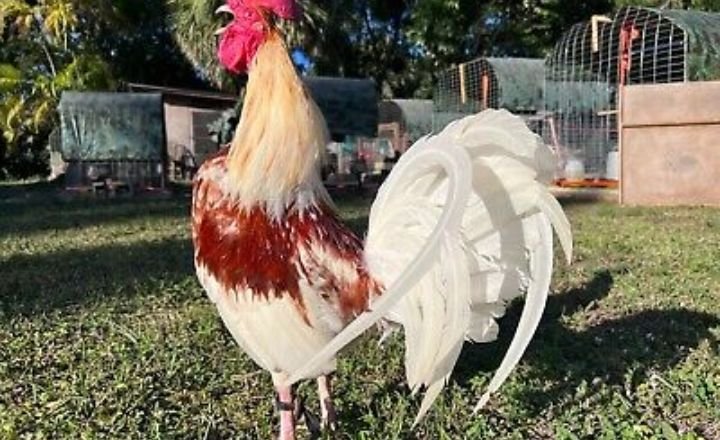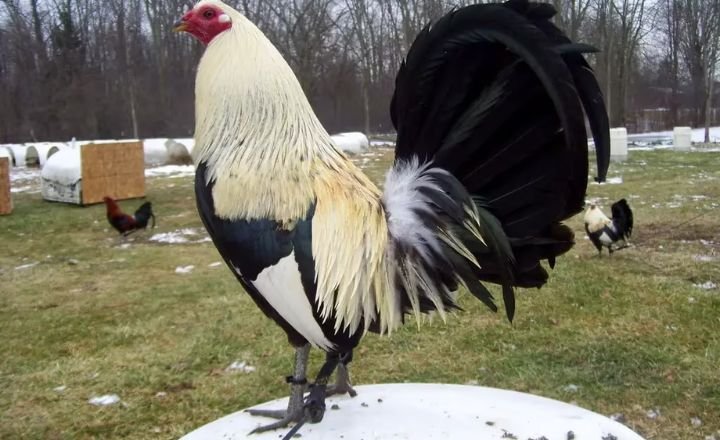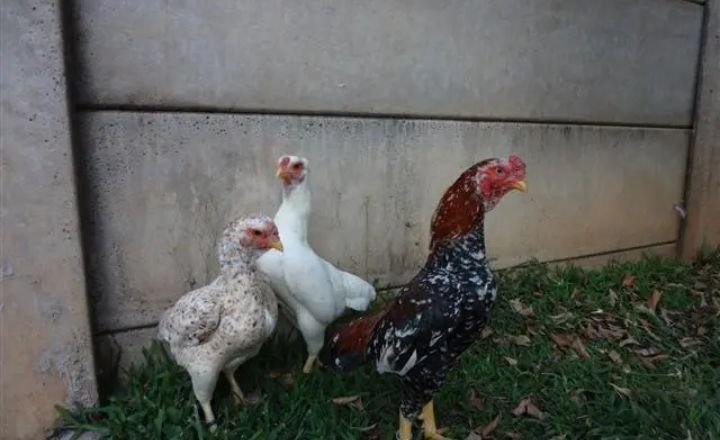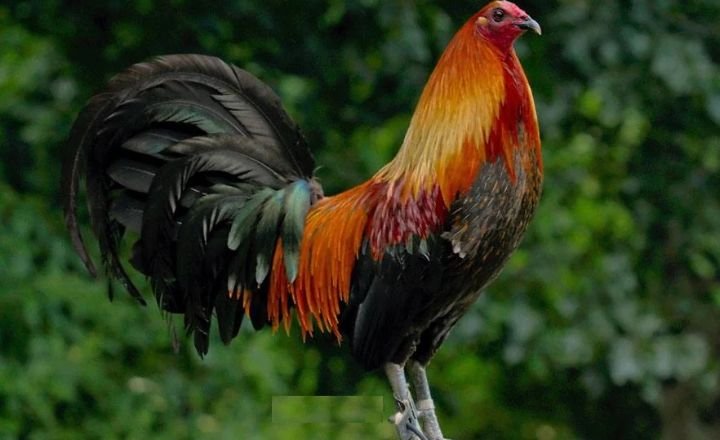The world of cockfighting, one cannot help but be captivated by the myriad of fighting rooster breeds that have been selectively bred for centuries. These magnificent birds are not just ordinary farmyard fowls, they are fierce, agile warriors with a rich history and lineage that dates back to ancient times.
The regal American Gamefowl with its striking plumage and powerful spurs to the elegant Spanish Gallos de Pelea known for their relentless fighting spirit, each breed has its own unique characteristics that make them formidable opponents in the arena.
Fighting Rooster Breeds
- Whitehackle
- American Game Chicken
- Shamo
- Old English Game Chicken
- Asil
- Sumatra
1. White Hackle
Whitehackles may appear innocent and unassuming at first glance, but beneath their unassuming exterior lies a fierce and formidable fighter. Known for their supernatural fighting skills, Whitehackles possess a cunning and strategic approach to combat that often catches their opponents off guard.

Their ability to hit hard and fast makes them incredibly dangerous adversaries in the world of game fowl fighting. Whitehackles apart from other breeds is their sheer opportunism on the battlefield.
They are quick to capitalise on any opening presented to them, delivering devastating blows with precision and efficiency.
The grey variation of the Whitehackle breed takes this aggressiveness to another level, showcasing a ferocity that can strike fear into the hearts of even the most seasoned opponents.
Appearance
The striking appearance of Whitehackle game birds serves as a testament to their unique characteristics. The combination of straight combed features, medium size, and red eyes creates an aura of elegance that is truly captivating.
Their broad shoulders and compact heavy plumage exude strength and resilience, while the deadly cutter high beak speaks volumes about their predatory nature.
Coat Colour
This distinct coloration of the gamefowl breed has long been a topic of fascination among enthusiasts and breeders alike. The white or grey base, coupled with the subtle mustard yellow tones, creates a stunning visual appeal that sets this breed apart from others.
The interplay of colours on the body showcases the intricate genetics and breeding efforts that have gone into creating such a unique palette.
Distinctive Feature
The juxtaposition of a majestic white coat against striking red eyes creates a captivating allure that is both mysterious and enchanting.
The purity and innocence conveyed by the white fur is juxtaposed with the intensity and ferocity emanating from the piercing red gaze, creating a mesmerising contrast that draws in the viewer’s attention.
Weight
2 to 2.5 kgs
Breed Purpose
2. American Game Chicken
American Game Chickens are not just about fighting; they also possess remarkable qualities that make them stand out in the world of poultry. Their noisy and active nature contributes to their dynamic persona, making them a fascinating breed to observe.

Their exceptional jumping and flying abilities, American Game Chickens showcase agility and grace in their movements, highlighting their overall athleticism.The resilience and tenacity displayed by these game birds are truly commendable.
Despite facing challenges and adversity, American Game Chickens continue to fight for survival, showcasing their determination and fierce spirit.Cockfighting may be illegal in many parts of the world, the legacy of these birds as fighters continues to live on through other means such as ornamental breeding or showcasing at events.
Appearance
American Game Chickens are revered for their exceptional physical characteristics that set them apart from other chicken breeds. Their strong muscular bodies paired with long sickle feathers give them a majestic and imposing appearance, reflecting their history as fighting birds.
Colour
The striking variety of colours found in the American Game Chicken breed reflects the diversity and beauty of nature. Each colour variation adds a unique touch to these magnificent birds, turning them into living works of art.
From fiery reds to earthy browns and sleek silvers, each hue tells a story of evolution and adaptation.
Distinctive Feature
The intricate features of the five-pointed single comb and long sickle feathers tell a story of resilience and elegance in poultry breeds.
The five points on the comb serve both a functional and aesthetic purpose, helping to regulate body temperature while also adding a touch of beauty to the bird’s appearance.
Weight
4 to 5 kgs
Breed Purpose
Fighting and show birds
3. Shamo
The unique appearance and characteristics of Shamo game birds have not only fascinated enthusiasts in Thailand but also garnered immense popularity in Japan, they are highly valued for their prowess in combat and ornamental beauty.

The cross-breeding of Shamos has led to the development of several distinct breeds, with only seven officially recognized by authorities. These include Ehigo-Nankin-Shamo, Kinpa, Ko-Shamo, Nankin-Shamo, Yakido (or Yagido), and Yamato-Shamo or Yamato Gunkel.
Chu-Shamo and Chibi-Shamo have also emerged as popular unregistered variants among breeders.The intense aversion towards other chickens and penchant for human interaction, Shamos exhibit a supernaturally aggressive nature typical of gamefowl.
Raising, these birds cannot be confined to cages due to their innate need for freedom and space. This blend of unique traits makes Shamos a captivating breed that continues to captivate the hearts of poultry enthusiasts around the world.
Appearance
Shamos are truly remarkable creatures that command attention with their distinct features. Their upright posture exudes strength and purpose, while the broad shoulders and well-muscled thighs speak to their agility and power.
The combination of bright red earlobes, yellow beaks, pear-shaped combs, and pearl coloured eyes creates a visually striking appearance that sets them apart from other gamebirds.
Colour
Shamo game fowls are known for their stunning appearances, commonly found in black, black-breasted red, and dark red hues. These colours not only enhance the aesthetics of these birds but also serve as a testament to their strong genetic traits and selective breeding.
The deep ebony of the black Shamo exudes an air of mystery and elegance, while the fiery tones of the black-breasted red variant showcase a bold and vibrant personality.
Distinctive feature
Pear-shaped combs and pearl coloured eyes
Weight
3 to 5 kgs
Breed purpose
Ornament, Fighting
4. Old English Game Chicken
The Old English Game Chickens’ rich history and unique characteristics truly set them apart from other chicken breeds. Despite their high maintenance nature, their striking appearances and captivating behaviours continue to fascinate enthusiasts worldwide.
The breed’s transition from being prized for their fighting skills to cherished as ornamental birds showcases a remarkable shift in societal values and attitudes towards animal welfare.
A variety of the Old English Game Chicken boasts its own distinct features and colour patterns, adding a vibrant array of options for breeders and collectors alike.
The elegant Black Breasted Red to the eye-catching Blue Silver Duckwing, each bird exudes a sense of elegance and charm that is hard to resist. These birds continue to captivate hearts with their beauty and grace, it is clear that the legacy of the Old English Game Chicken will endure for generations to come.
Appearance
The distinct features of the Old English Game Chicken serve as a testament to its rich history and unique genetic makeup. Their puffed out chest exuding confidence to their small tightly bound glossy feathers emitting an aura of elegance, these chickens effortlessly command attention.
The large necks and strong heads reflect their robust nature, while the well-curved beaks hint at their adaptability and efficiency in foraging for food.
Colour
The Old English Game Chicken is a captivating bird that comes in an array of visually stunning colours, making it a favourite among poultry enthusiasts. The sleek black and brown-red feathers to the vibrant ginger red and silver blue shades, each chicken-friendly colour adds a unique charm to these birds.
The sight of a flock of these colourful chickens grazing in the sunlight is truly a sight to behold, showcasing nature’s diverse palette.
Distinctive feature
Small tightly glossy bounded feathers, Puffed out chest, Single comb, well-curved beaks, and nails
Weight
1.16 to 2.26 kgs
Breed purpose
Fighting, show birds, ornament
5. Asil
Asil Game Birds represent a unique blend of strength, courage, and intelligence. While their aggressive nature towards fellow chickens cannot be denied, their capacity for loyalty and affection towards humans is a surprising contradiction.
The Asil’s ability to be tamed and trained speaks volumes about their adaptability and willingness to form bonds beyond the fighting pit.Their reputation for being formidable fighters, Asils are not as resilient in adverse climates compared to other breeds.
This vulnerability adds a layer of complexity to these birds, highlighting the delicate balance between their fierce instincts and their underlying fragility in certain environmental conditions.
Appearance
The striking appearance of Aseels is a testament to their unique genetic makeup and centuries-old breeding practices. Their multi-colored coats, upright bodies, and strong shanks are not just for show; they serve as indicators of the breed’s robust health and resilience.
The red-coloured pea combs add a touch of elegance to their overall look, while the glossy hard feathers gleam in the sunlight like polished armour.
Colour
Multi chicken-like colours, glossy hard feathers, and pea combs.
Distinctive feature
The multicoloured coat,
Weight
3.5 to 4 kgs
6. Sumatra
Sumatra chickens, with their striking appearance and fierce fighting skills, have captivated poultry enthusiasts around the world. Originating from the lush island of Sumatra in Indonesia, these gamebirds showcase a unique blend of wildfowl and Feral Kampong heritage.
Their recognition by the American Poultry Association in 1883 solidified their status as a prized breed popular for both their beauty and combat prowess. It’s fascinating to see how this breed, known for its aggressive nature, has also charmed many as friendly pets with their engaging behaviour.
The significance of Sumatra chickens in regions like Asia and the Subcontinent, where they are cherished for their aerial acrobatics and energetic demeanour. The demand for Sumatra Black or Sumatra Game birds continues to rise not just in their country of origin but also across continents like Europe and North America.
Appearance
The striking appearance of Sumatra chickens sets them apart from other breeds, with their mesmerising greenish-black coats that shimmer under the sunlight.
The graceful long tails of these birds bear a resemblance to the elegant Yokohama chickens, showcasing their regal and dignified presence in any flock.
Their glossy feathers, coloured in a unique blackish-green hue, add an air of mystery and allure to these majestic creatures.
Colour
Greenish-black
Distinctive feature
Graceful long tail, yellow soles, and small combs
Weight
2.5 to 3 kgs
Breed purpose
Fighting, ornament
6. Sumatra
Sumatra game birds are not just known for their fighting skills but also for their stunning appearance. Their glossy black feathers and regal stance make them a sight to behold, captivating the hearts of all who admire them.
The recognition by the American Poultry Association in 1883 solidified their place as a prized breed in the poultry world. Sumatra chickens continue to be in high demand in the USA and Europe, where enthusiasts appreciate their unique qualities.
Their agility and spirited nature, Sumatras bring excitement and energy to any flock or farm they inhabit. Whether raised for fighting or simply as cherished pets, these birds never fail to leave a lasting impression with their grace and charm.
Appearance
A stunning flock of Sumatra chickens roaming free, their greenish-black coats shimmering in the sunlight. These birds, with their graceful long tails reminiscent of Yokohama chickens, truly stand out among other breeds.
The blackish-green glossy feathers add to their allure, creating a striking appearance that commands attention.
Colour
Greenish-black
Distinctive feature
Graceful long tail, yellow soles, and small combs
Weight
2.5 to 3 kgs
Breed purpose
The well-known Gamefowl breeds often steal the spotlight, it’s important to shed light on the equally exceptional but lesser-known breeds that deserve recognition. One such breed is the Liege Fighter, a Belgian gamefowl with a long history of being bred for its fighting prowess and impressive ornamental features.
Its striking appearance and strong fighting abilities, this breed remains relatively obscure compared to its more famous counterparts.
These least-known game birds are;
- Brown Red Gamefowl
- Lemon Fowl
7. Brown Red Gamefowl
The Brown Red Gamefowl may not boast the same level of fame as its counterparts, yet it holds its own with a unique blend of characteristics. Primarily bred for cockfighting prowess, this breed’s impressive running ability sets it apart and showcases a different dimension to its skills.

The striking colour combinations of the Brown Red Gamefowl give them an exclusive and elite appearance that commands attention in any setting.
A being somewhat overlooked in comparison to more renowned game fowl breeds, the Brown Red Gamefowl has made its mark by earning recognition from esteemed bodies like the American Standard Of Perfection.
Appearance
A speedster takes flight, its graceful long tail streaming behind like a silken ribbon in the wind. The contrast of its greyish black legs against the vibrant ginger feathers creates a striking visual feast for the eyes.
In flight, it moves with such precision and elegance that one cannot help but be captivated by its sheer beauty and agility.
Colour
Multi-colored brown red black and ginger-coloured
Distinctive feature
Graceful long tail, and short rounded head
Weight
3 to 4 kgs
Breed purpose
Pet, Fighting, meat
8. Lemon Fowl
The enigmatic Lemon Fowl from Germany may be a lesser-known fighting bird breed, but its allure lies in its striking appearance and exceptional combat skills. Despite being bred and crossbred numerous times, this breed has managed to retain its unique coloration, adding to its mystique.
Their fighting style is calculated and methodical, luring opponents in before delivering a devastating blow with precision. Little information available in historical records or online sources, the true essence of these birds remains shrouded in mystery.
Keepers of Lemon Fowls are perhaps the sole bearers of knowledge about their captivating personalities and innate abilities. It is through their care and understanding that the true majesty of these birds is brought to light, showcasing their resilience and tenacity in the world of avian combat sports.
Appearance
The unique blend of colours in the coat of the Lemon Fowl is a sight to behold, reflecting the intricacies of nature’s design. The juxtaposition of straight red feathers against lemon heckles creates a striking visual contrast that speaks to the bird’s individuality.
Coupled with its short round head and well-covered yellow legs, this breed exemplifies a harmonious fusion of different hues.
Colour
Multi-colored but as the name of the rooster tells lemon so colour is lemon.
Distinctive feature
Multi-colored coat, covered legs, short well-rounded head
Weight
2. 5 to 3 kgs
Breed purpose
Meat, Fighting
Final Thought
Fighting rooster breeds have a long history and are known for their unique characteristics and capabilities in the world of cockfighting. From the agile and fierce Shamo to the powerful and imposing Asil, each breed brings its own strengths to the arena.
The ethics of cockfighting continue to be a subject of debate, enthusiasts are drawn to these breeds for their beauty, strength, and resilience. It is important for those interested in raising fighting roosters to understand the responsibilities that come with it, including providing proper care and training.
A navigating the ethical considerations of this sport, it is essential to appreciate the dedication and passion that breeders have for these remarkable birds
FAQs
What breed of rooster is used for fighting?
The breed of rooster most commonly used for fighting is the American Gamefowl. These roosters are known for their aggressive behavior, strength, and endurance, making them popular choices for cockfighting. They are bred specifically for their fighting abilities and have a long history of being used in this brutal sport.
Are rooster fights illegal?
Yes, rooster fights are illegal in many countries around the world due to concerns about animal cruelty and unethical treatment of animals. In the United States, for example, rooster fighting is banned in all 50 states as it is considered a form of animal cruelty and is punishable by law.
Do roosters fight naturally?
Yes, roosters have a natural instinct to establish dominance within their flock, which can lead to fighting. Roosters may fight over food, territory, or mating rights with hens. This behavior is ingrained in their nature as they try to assert their position as the leader of the group.
